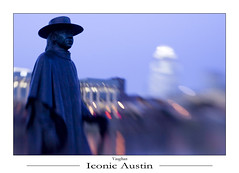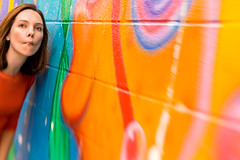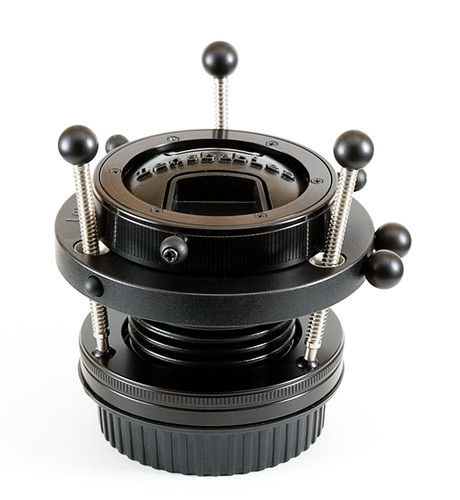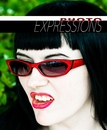Lensbabies
I have a couple of lensbabies. Looking like the offspring of a vacuum cleaner and a camera lens, these fun little lenses let you create images with selective focus through the focal plane. There is a sweet region in focus that can be moved around by bending, pushing and pulling the lens. The lens aperture is controlled by dropping physical rings right into the lens, held in place by tiny magnets. There are several generations of lensbabies and I recently purchased the more robotic looking lensbaby 3G which allows finer focus control and repeatability - perfect for shooting on a tripod or with the need for more control. The 3G lensbaby also comes with aperture rings all the way down to f22, something I haven't yet played with.
There are a few features about the lensbaby that I really enjoy:
First, the organic nature of shooting with it. Because you have to constantly manipulate the lens to change the focus point on the frame, pushing and pulling it to focus at different distances, bending and twisting the lens to move the sweet spot around the composition, it leads to a very tactile way of shooting. Often the question is asked Why can't you just do it in Photoshop? Partly this is because the final effect of the lensbaby would be hard to achieve, but mainly the difference is doing it in Photoshop, you'd just shoot normally and consciously add blur after the fact. With a lensbaby, you do it right then and there. Reacting to the scene through the camera, not thinking so much, there is less control which leads to maybe more happy accidents but also to you doing things you'd never try in Photoshop. The results for me are just totally different. Looking through a lensbaby changes how I'd compose the scene and how I would approach the subject - something that is lost if I try to do it later.
manipulate the lens to change the focus point on the frame, pushing and pulling it to focus at different distances, bending and twisting the lens to move the sweet spot around the composition, it leads to a very tactile way of shooting. Often the question is asked Why can't you just do it in Photoshop? Partly this is because the final effect of the lensbaby would be hard to achieve, but mainly the difference is doing it in Photoshop, you'd just shoot normally and consciously add blur after the fact. With a lensbaby, you do it right then and there. Reacting to the scene through the camera, not thinking so much, there is less control which leads to maybe more happy accidents but also to you doing things you'd never try in Photoshop. The results for me are just totally different. Looking through a lensbaby changes how I'd compose the scene and how I would approach the subject - something that is lost if I try to do it later.
 The second thing I really like about a lensbaby is how it treats highlights in the out of focus areas. I'm used to round or at least regular bokeh, but if you push and bend a lensbaby enough you get elliptical bokeh which I just find fascinating, particularly on bright spots in the out of focus regions. You can see those elliptical effects in the statue image above. I'm intrigued by the idea of cutting custom aperture disks with stars or different shapes to further play with the OOF highlights. I've recently heard that Lensbaby are going to be selling custom aperture kits, star & heart shapes plus several blanks to cut your own. This effect is particularly attractive for city night photography - lots of point light sources that render the aperture shape when out of focus.
Compositionally, I find a couple of good or common uses for the lensbaby The first ways it gets used is to control confusion. Many fans of the lens use it for street portraiture, where the backgrounds or edges of the frame might well be chaotic. The lensbaby helps here by throwing those regions out of focus and helps you pay attention to the subject. The build in focus vignetting allows the photographer to worry about the subject and expect everything else to just blur into the background.
The second thing I really like about a lensbaby is how it treats highlights in the out of focus areas. I'm used to round or at least regular bokeh, but if you push and bend a lensbaby enough you get elliptical bokeh which I just find fascinating, particularly on bright spots in the out of focus regions. You can see those elliptical effects in the statue image above. I'm intrigued by the idea of cutting custom aperture disks with stars or different shapes to further play with the OOF highlights. I've recently heard that Lensbaby are going to be selling custom aperture kits, star & heart shapes plus several blanks to cut your own. This effect is particularly attractive for city night photography - lots of point light sources that render the aperture shape when out of focus.
Compositionally, I find a couple of good or common uses for the lensbaby The first ways it gets used is to control confusion. Many fans of the lens use it for street portraiture, where the backgrounds or edges of the frame might well be chaotic. The lensbaby helps here by throwing those regions out of focus and helps you pay attention to the subject. The build in focus vignetting allows the photographer to worry about the subject and expect everything else to just blur into the background.
 Something I'm finding even stronger is to use it when there are specific regions that have strong design elements that I want to throw out of focus. These aren't regions that are clutter or distracting, but just sections that will retain a strong compositional element when out of focus. Examples of this are the strongly coloured, stripped shirt or the person at the edge of the pool. In both cases, the selective focus doesn't diminish the contribution of those regions. The person is still recogniseable, the stripes and colours of the shirt are still part of the composition; but the softening of focus strengthens their contribution as elements of design. They become more abstract and act as powerful framing elements.
The fish portrait of Amanda is another example of consciously using the lens blur to focus on her face; not to control any confusing elements from the fish but more to turn it into a stronger design element of the scene. The leading lines and colour becomes even more relevant with the selective focus, rather than being hidden or removed from the scene by the blur.
Something I'm finding even stronger is to use it when there are specific regions that have strong design elements that I want to throw out of focus. These aren't regions that are clutter or distracting, but just sections that will retain a strong compositional element when out of focus. Examples of this are the strongly coloured, stripped shirt or the person at the edge of the pool. In both cases, the selective focus doesn't diminish the contribution of those regions. The person is still recogniseable, the stripes and colours of the shirt are still part of the composition; but the softening of focus strengthens their contribution as elements of design. They become more abstract and act as powerful framing elements.
The fish portrait of Amanda is another example of consciously using the lens blur to focus on her face; not to control any confusing elements from the fish but more to turn it into a stronger design element of the scene. The leading lines and colour becomes even more relevant with the selective focus, rather than being hidden or removed from the scene by the blur.
 One initial problem I had with the lensbaby was trying to shoot it wide open. The lens without any aperture rings is around f2.0 which gives a very narrow depth of field for this ~50mm focal length lens. When I started using f4 or f5.6 rings to practice I started getting more frames where something was in focus! It is also difficult with a second generation lensbaby to push the sweet spot too far to the edge of the frame. It is possible but you do start to get to a point where nothing is in focus at all. The 3G lensbaby is easier to distort even more in this respect, due to the fine focus controls and ability to fix the bend and then move the camera around.
All of the shots on this page were taken with a 2G lensbaby. I'm just starting to explore the possibilities that the 3G provides. I can see it being usable for self portraits because of the fixable lens flex, usable for landscapes because of the smaller aperture disks, more usable for studio portraiture given the repeatability inherent in fixing the lens and perhaps also for HDR and other types of photography that require multiple exposures of the same scene. I've already shot a few self-portraits with the 3G lensbaby and tried some night photography. It isn't easy manually focusing in the near dark!
One initial problem I had with the lensbaby was trying to shoot it wide open. The lens without any aperture rings is around f2.0 which gives a very narrow depth of field for this ~50mm focal length lens. When I started using f4 or f5.6 rings to practice I started getting more frames where something was in focus! It is also difficult with a second generation lensbaby to push the sweet spot too far to the edge of the frame. It is possible but you do start to get to a point where nothing is in focus at all. The 3G lensbaby is easier to distort even more in this respect, due to the fine focus controls and ability to fix the bend and then move the camera around.
All of the shots on this page were taken with a 2G lensbaby. I'm just starting to explore the possibilities that the 3G provides. I can see it being usable for self portraits because of the fixable lens flex, usable for landscapes because of the smaller aperture disks, more usable for studio portraiture given the repeatability inherent in fixing the lens and perhaps also for HDR and other types of photography that require multiple exposures of the same scene. I've already shot a few self-portraits with the 3G lensbaby and tried some night photography. It isn't easy manually focusing in the near dark!
 manipulate the lens to change the focus point on the frame, pushing and pulling it to focus at different distances, bending and twisting the lens to move the sweet spot around the composition, it leads to a very tactile way of shooting. Often the question is asked Why can't you just do it in Photoshop? Partly this is because the final effect of the lensbaby would be hard to achieve, but mainly the difference is doing it in Photoshop, you'd just shoot normally and consciously add blur after the fact. With a lensbaby, you do it right then and there. Reacting to the scene through the camera, not thinking so much, there is less control which leads to maybe more happy accidents but also to you doing things you'd never try in Photoshop. The results for me are just totally different. Looking through a lensbaby changes how I'd compose the scene and how I would approach the subject - something that is lost if I try to do it later.
manipulate the lens to change the focus point on the frame, pushing and pulling it to focus at different distances, bending and twisting the lens to move the sweet spot around the composition, it leads to a very tactile way of shooting. Often the question is asked Why can't you just do it in Photoshop? Partly this is because the final effect of the lensbaby would be hard to achieve, but mainly the difference is doing it in Photoshop, you'd just shoot normally and consciously add blur after the fact. With a lensbaby, you do it right then and there. Reacting to the scene through the camera, not thinking so much, there is less control which leads to maybe more happy accidents but also to you doing things you'd never try in Photoshop. The results for me are just totally different. Looking through a lensbaby changes how I'd compose the scene and how I would approach the subject - something that is lost if I try to do it later.
 The second thing I really like about a lensbaby is how it treats highlights in the out of focus areas. I'm used to round or at least regular bokeh, but if you push and bend a lensbaby enough you get elliptical bokeh which I just find fascinating, particularly on bright spots in the out of focus regions. You can see those elliptical effects in the statue image above. I'm intrigued by the idea of cutting custom aperture disks with stars or different shapes to further play with the OOF highlights. I've recently heard that Lensbaby are going to be selling custom aperture kits, star & heart shapes plus several blanks to cut your own. This effect is particularly attractive for city night photography - lots of point light sources that render the aperture shape when out of focus.
Compositionally, I find a couple of good or common uses for the lensbaby The first ways it gets used is to control confusion. Many fans of the lens use it for street portraiture, where the backgrounds or edges of the frame might well be chaotic. The lensbaby helps here by throwing those regions out of focus and helps you pay attention to the subject. The build in focus vignetting allows the photographer to worry about the subject and expect everything else to just blur into the background.
The second thing I really like about a lensbaby is how it treats highlights in the out of focus areas. I'm used to round or at least regular bokeh, but if you push and bend a lensbaby enough you get elliptical bokeh which I just find fascinating, particularly on bright spots in the out of focus regions. You can see those elliptical effects in the statue image above. I'm intrigued by the idea of cutting custom aperture disks with stars or different shapes to further play with the OOF highlights. I've recently heard that Lensbaby are going to be selling custom aperture kits, star & heart shapes plus several blanks to cut your own. This effect is particularly attractive for city night photography - lots of point light sources that render the aperture shape when out of focus.
Compositionally, I find a couple of good or common uses for the lensbaby The first ways it gets used is to control confusion. Many fans of the lens use it for street portraiture, where the backgrounds or edges of the frame might well be chaotic. The lensbaby helps here by throwing those regions out of focus and helps you pay attention to the subject. The build in focus vignetting allows the photographer to worry about the subject and expect everything else to just blur into the background.
 Something I'm finding even stronger is to use it when there are specific regions that have strong design elements that I want to throw out of focus. These aren't regions that are clutter or distracting, but just sections that will retain a strong compositional element when out of focus. Examples of this are the strongly coloured, stripped shirt or the person at the edge of the pool. In both cases, the selective focus doesn't diminish the contribution of those regions. The person is still recogniseable, the stripes and colours of the shirt are still part of the composition; but the softening of focus strengthens their contribution as elements of design. They become more abstract and act as powerful framing elements.
The fish portrait of Amanda is another example of consciously using the lens blur to focus on her face; not to control any confusing elements from the fish but more to turn it into a stronger design element of the scene. The leading lines and colour becomes even more relevant with the selective focus, rather than being hidden or removed from the scene by the blur.
Something I'm finding even stronger is to use it when there are specific regions that have strong design elements that I want to throw out of focus. These aren't regions that are clutter or distracting, but just sections that will retain a strong compositional element when out of focus. Examples of this are the strongly coloured, stripped shirt or the person at the edge of the pool. In both cases, the selective focus doesn't diminish the contribution of those regions. The person is still recogniseable, the stripes and colours of the shirt are still part of the composition; but the softening of focus strengthens their contribution as elements of design. They become more abstract and act as powerful framing elements.
The fish portrait of Amanda is another example of consciously using the lens blur to focus on her face; not to control any confusing elements from the fish but more to turn it into a stronger design element of the scene. The leading lines and colour becomes even more relevant with the selective focus, rather than being hidden or removed from the scene by the blur.
 One initial problem I had with the lensbaby was trying to shoot it wide open. The lens without any aperture rings is around f2.0 which gives a very narrow depth of field for this ~50mm focal length lens. When I started using f4 or f5.6 rings to practice I started getting more frames where something was in focus! It is also difficult with a second generation lensbaby to push the sweet spot too far to the edge of the frame. It is possible but you do start to get to a point where nothing is in focus at all. The 3G lensbaby is easier to distort even more in this respect, due to the fine focus controls and ability to fix the bend and then move the camera around.
All of the shots on this page were taken with a 2G lensbaby. I'm just starting to explore the possibilities that the 3G provides. I can see it being usable for self portraits because of the fixable lens flex, usable for landscapes because of the smaller aperture disks, more usable for studio portraiture given the repeatability inherent in fixing the lens and perhaps also for HDR and other types of photography that require multiple exposures of the same scene. I've already shot a few self-portraits with the 3G lensbaby and tried some night photography. It isn't easy manually focusing in the near dark!
One initial problem I had with the lensbaby was trying to shoot it wide open. The lens without any aperture rings is around f2.0 which gives a very narrow depth of field for this ~50mm focal length lens. When I started using f4 or f5.6 rings to practice I started getting more frames where something was in focus! It is also difficult with a second generation lensbaby to push the sweet spot too far to the edge of the frame. It is possible but you do start to get to a point where nothing is in focus at all. The 3G lensbaby is easier to distort even more in this respect, due to the fine focus controls and ability to fix the bend and then move the camera around.
All of the shots on this page were taken with a 2G lensbaby. I'm just starting to explore the possibilities that the 3G provides. I can see it being usable for self portraits because of the fixable lens flex, usable for landscapes because of the smaller aperture disks, more usable for studio portraiture given the repeatability inherent in fixing the lens and perhaps also for HDR and other types of photography that require multiple exposures of the same scene. I've already shot a few self-portraits with the 3G lensbaby and tried some night photography. It isn't easy manually focusing in the near dark!





2 comments:
Great stuff Gordon. Thanks for sharing your interesting thoughts.
Sam
I want one of those so bad! LOL
Excellent series to show its capabilities too!
the image of it is superb!
Post a Comment